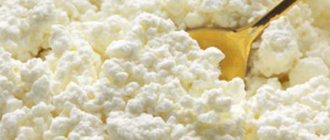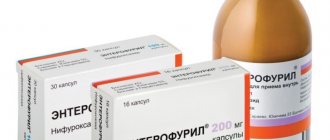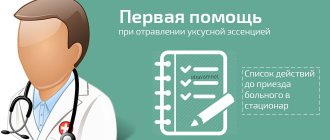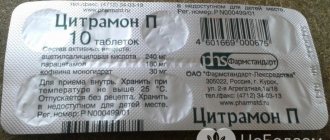Probably, every person at least once in his life has encountered food poisoning, accompanied by very unpleasant symptoms. This pathological condition can be caused by the consumption of low-quality or expired products, failure to comply with sanitary standards in the process of preparing dishes, or violation of technology during the cooking process. In case of severe food poisoning, people can experience very dangerous complications, some of which can even lead to death.
Symptoms
After a person is poisoned, characteristic symptoms begin to appear, which allows one to suspect something is wrong and contact a hospital for help.
People should not ignore the following clinical manifestations of food poisoning:
- nausea begins;
- one-time or repeated vomiting occurs;
- cold sweat appears;
- chills appear;
- severe diarrhea begins;
- weakness appears, etc.
How long does it take for people to become poisoned?
If a person is poisoned in an acute form, then the first signs may appear within an hour from the moment of eating dangerous food. In this case, symptoms of intoxication will be observed within a week.
Modern medicine classifies food poisoning as follows:
- Bacterial. Pathogenic bacteria enter the human body along with food, which immediately begin active life in the intestines.
- Non-bacterial. In this case, intoxication of the body can occur when consuming poisonous mushrooms, berries, and plants.
Most often, people have to deal with the following pathogenic pathogens:
- salmonella;
- botulinum;
- coli;
- staphylococci.
Bacterial form
If pathogenic microorganisms such as Escherichia coli or staphylococcus enter the human body along with food, he will notice signs of intoxication within thirty minutes after the meal.
He will begin to exhibit the following clinical picture:
- will begin to feel very sick;
- the condition will rapidly deteriorate;
- vomiting occurs;
- general weakness will appear;
- chills will begin;
- painful sensations will appear in the stomach area;
- the temperature will rise;
- severe diarrhea will begin;
- pressure will decrease;
- signs of an allergic reaction are observed.
If the victim seeks medical help in a timely manner, his condition will be stabilized and improvement will soon occur.
The following products can provoke this pathological condition:
- stale fish;
- caviar, milk and liver of pike, perch and beluga, which become toxic during the spawning period;
- improperly prepared fish dishes;
- low-quality meat;
- meat dishes that have not undergone sufficient heat treatment.
Salmonellosis
When salmonella enters the human body, signs of intoxication will appear within 24 hours. The danger of such poisoning is that dehydration occurs against the background of severe diarrhea and vomiting. In the absence of timely drug therapy for patients, everything can end in death. Salmonellosis is accompanied by characteristic symptoms:
- vomiting begins;
- severe diarrhea occurs;
- painful sensations appear in the stomach;
- the temperature rises to 40 degrees;
- headaches occur.
Botulism
When the body is infected, poisoning appears within a few hours, which cannot be dealt with at home.
Botulism is accompanied by the following symptoms:
- aches appear in the body;
- functions are impaired: respiratory and visual;
- weakness occurs;
- there are difficulties when swallowing.
Pathogenic microflora enters the human body when consumed:
Shigella
When consuming low-quality milk and dairy products, people may experience food poisoning, the symptoms of which will appear within 1-7 days. from the moment a pathogenic bacterium enters the intestine. In case of intoxication, the following clinical picture will be observed:
- loss of appetite;
- headache;
- muscle and joint weakness;
- heat;
- convulsions;
- diarrhea;
- loss of consciousness.
Non-bacterial form
When people consume poisonous mushrooms, berries and plants, they show signs of intoxication within four hours:
- severe diarrhea;
- yellowing of the skin (48-72 hours after the toxin enters the blood);
- tremor.
In case of drug poisoning, signs of intoxication appear within a time period varying from 30 minutes to 30 minutes. until 3 o'clock
Intoxication can occur in a person of any age. You can be poisoned by food, medicines, chemicals, and alcohol. How long it takes for poisoning to manifest depends primarily on the type of toxin and the state of the human body. Moreover, children react more sharply to the penetration of toxic substances.
How many hours does it take for food poisoning to appear?
Intoxication with low-quality food often occurs. They can be spoiled, contaminated with pathogenic microbes, or made from low-quality raw materials
After how many hours food poisoning occurs and manifests itself, the duration of the incubation period, that is, the time from the moment of penetration of the toxic substance until the appearance of symptoms of poisoning, depends on the type of product. How many hours later does poisoning with meat, fish, mushrooms and other food products occur? We’ll talk about it below.
First steps for intestinal disease in a child
Emergency care for a sick baby depends on her weight and age. If the baby is under 5 years old, then parents should urgently call an ambulance and all necessary procedures will be carried out by qualified specialists in a hospital setting. It is important to provide doctors with information about how many hours later the first signs of the disease appeared.
If the child is over 5 years old, parents can rinse the stomach at home. This procedure will help the body quickly get rid of E. coli. For gastric lavage, boiled water, a soda solution (1 tablespoon per liter of water) or a pale pink solution of potassium permanganate are suitable. The child should be encouraged to drink approximately 2 liters of liquid and then vomited. Carry out the procedure until clear water appears in the vomit.
Parents can rinse their child's stomach at home
Some time after gastric lavage, doctors prescribe the child the necessary enterosorbents, which help neutralize toxins in the intestines. If the baby needs to be given a tablet, then the parents crush it, mix it with a small amount of water and give it to the baby.
Severe vomiting and diarrhea contribute to fluid loss. Therefore, parents are advised to give their child food often and in small quantities (a couple of sips of liquid every 10-15 minutes) to prevent dehydration. To drink, the baby is given rice water, weak tea, compote, raisin water, or they buy special saline solutions at the pharmacy.
Time of onset of symptoms of chemical intoxication
Intoxication with chemicals can occur both at work and at home. Most often, poisoning is recorded from chlorine-containing chemicals, which are widely used by housewives during cleaning.
Poisoning can occur under the following conditions:
- Inhalation of vapors of chlorine-containing substances;
- Consumption of household chemicals in food. This can happen through negligence when a small child decides to taste a liquid that is unfamiliar to him. And also for the purpose of suicide.
The victim has difficulty breathing in the form of shortness of breath and a sore throat. Later (after 1 – 4 hours) pulmonary edema develops. The speed of its development depends on the concentration and dosage of the toxic substance.
When a chemical penetrates the gastrointestinal tract, poisoning develops immediately or after several hours. The first symptom is nausea and vomiting.
Preventive actions
Food poisoning is now far from uncommon, and rush hour is during the summer season. Therefore, if you find yourself in such a situation, there is no need to panic, just follow the previously described instructions for eliminating these symptoms.
The system of preventive measures consists of the following points:
- wash your hands with soap before sitting at the table, after a walk, visiting the bathroom, stroking animals and in other cases;
- pour boiling water over raw vegetables and fruits. If they are bought at the market, it is better to let them sit for a while in warm water, because they are very often treated with a substance to preserve their shelf life;
- do not give your child unboiled milk, poorly cooked meat, raw chicken eggs and similar products;
- Keep prepared meals in the refrigerator for no more than 2 days;
- check the expiration date and storage order of products in the shopping center. If any shortcomings are found, inform the Administrator;
- do not feed the child unfamiliar foods, fruits, vegetables;
- Never prescribe medication dosage yourself.
If these measures are followed, the baby will always be cheerful, smart and happy.
Be healthy!
How many hours does it take for poisoning and drug overdose to appear?
Causes of drug intoxication:
- Exceeding the dose (overdose);
- Incorrect dose calculation;
- Simultaneous use of incompatible drugs (this is indicated in the instructions for the drug);
- Alcohol and drug use.
Table of incubation period for drug intoxication and symptoms of poisoning:
| Drug group or name | Incubation period | First symptoms |
| Clonidine (hypotensive agent) | 60 minutes | There is severe weakness, drowsiness, and coordination is impaired. Loss of consciousness occurs soon (30–60 minutes after the first signs of intoxication appear) |
| Paracetamol (antipyretic), especially dangerous when combined with alcoholic beverages | From 2 to 4 hours | Nausea occurs, which is accompanied by vomiting. Appetite is sharply reduced or completely absent. later pain occurs in the projection of the liver (right hypochondrium). If left untreated, the patient dies 1 week later from severe multiple organ failure (impaired functioning of the liver, kidneys, pancreas). |
| Sleeping pills | From 30 to 120 minutes | Severe weakness, impaired consciousness up to loss. In severe cases, coma quickly develops. If help is not provided quickly, death will occur within 2 to 6 hours, depending on the dose of the drug taken. |
| Insulin (hormonal agent) | From 60 to 120 minutes. And with an overdose of slow insulin, the first signs appear after 6–12 hours. | Tremor, severe weakness, impaired consciousness, rapid pulse. Hypoglycemic coma develops quickly. |
Symptoms and period of manifestation of alcohol intoxication
Ethanol quickly overcomes all barriers and penetrates the blood. The rate of development of alcohol intoxication depends on several factors:
- State of the body (presence of chronic pathologies);
- The dose of alcohol entering the digestive tract;
- Last meal.
It should be noted that even minor alcohol consumption on an empty stomach leads to the development of intoxication. How long does it take for symptoms of poisoning to appear? Symptoms appear within 30 minutes after drinking alcohol. Eating food together with alcohol somewhat slows down the development of poisoning. In this case, the first signs appear after 1.5 - 2 hours.
The first signs of alcohol poisoning:
- Euphoria (high spirits, fun, talkativeness);
- Discoordination, unsteady gait;
- Impaired fine motor skills.
Further alcohol consumption leads to the development of aggression and impaired consciousness. In severe cases, coma and death occur. The lethal concentration of ethanol in the blood is 4%.
Video: constant diarrhea with Elena Malysheva
Read further:
How long does alcohol intoxication and hangover last for the body ❶ ❷ ❸
The causative agent of salmonellosis
How to start a new life without alcohol
How to understand that a person is addicted to alcohol
How to help a child with diarrhea?
Article rating:
( 1 ratings, average: 5.00 out of 5)
Share with friends:
You may also be interested in:
What to do in case of poisoning at sea: list of medications for vacation
Gasoline poisoning
St. John's wort for poisoning for adults and children - methods of application
Poisoning and intoxication of the brain - causes and consequences of poisoning
How long does it take for poisoning to appear in children?
Poisoning develops faster in children than in adults. Intoxication occurs especially quickly and severely in children under one year of age.
The rate of development of intoxication depends on a number of factors:
- Child's age;
- Type of toxin;
- The amount of toxic substance that has entered the body;
- Health status;
- Individual developmental characteristics.
It should be noted that in some cases, when consuming the same products, poisoning occurs in children, but not in adults. What is this connected with? Adults, unlike children, have more advanced mechanisms for protecting the body from toxins. The smaller the child, the greater the likelihood of developing intoxication.
Factors contributing to the development of poisoning in children when toxins enter the body:
- Low acidity in the stomach. Many bacteria are able to pass this barrier;
- Rapid absorption of toxins in the oral cavity and other parts of the digestive tract. In children, these mucous membranes are better supplied with blood than in adults, and metabolic processes proceed much faster;
- Imperfect filtration function of the kidneys;
- Imperfection of the enzymatic system.
In children, poisoning most often manifests itself a few hours after the toxic substance enters the body, sometimes the incubation period lasts 2 days.
Victor Systemov - expert of the 1Travmpunkt site
Heavy
Serious poisonings include mushroom intoxication, botulism, staphylococcus or salmonellosis. Such intoxications are quite difficult.
Characteristic signs of severe intoxication include the following:
- Uncontrollable vomiting;
- Prolonged, persistent diarrhea;
- Hyperthermia at 39 degrees or higher;
- Fecal fluid has bloody inclusions;
- Salivation is noticeably increased, even to the point of drooling;
- There are some visual disturbances such as double vision, hazy haze or blurred images;
- The victim may lose consciousness or faint;
- Blood pressure readings increase noticeably;
- The volume of urine, as well as its specific gravity, is critically reduced.
If the victim experiences a similar clinical picture, immediate professional medical attention is required. The duration of such poisoning will depend entirely on the type of pathogen, the speed of medical care and the quality of therapy.
Staphylococcus may manifest itself for another couple of days, but intoxication with fungi or salmonella will bother you for at least 5-6 days. The prognosis for botulism is often poor.
Much depends on the state of the victim’s intraorganic structures, how the liver and kidneys, intestinal structures, etc. work. If these organs are in good health, recovery will occur much faster.
Types of poisoning and their main symptoms
All poisonings are divided into 2 large groups: microbial and non-microbial. The first include food intoxication (develops when a large number of bacterial toxins enter the gastrointestinal tract) and intestinal toxic infections (diseases caused primarily by microbes). Depending on the route of entry of the toxic substance, diseases are divided into three groups:
- food (fecal-oral mechanism, food route of bacterial penetration);
- respiratory (the toxic substance penetrates through the air and is represented by gas or steam);
- percutaneous (through the skin).
- acute (characterized by a violent clinical picture with a short incubation period);
- chronic (develop with prolonged intake of substances into the body).
Depending on the conditions of occurrence, poisoning is divided into:
- intentional;
- suicidal;
- unintentional (alcohol, household, industrial, medical, biological and poisoning associated with substance abuse and drug use).
- microbes and their toxins;
- fungi;
- aerosols and vapors;
- acids and alkalis;
- alcohol and alcohol substitutes;
- poisonous mushrooms (fly agaric, toadstool, false mushrooms), plants (hemlock, belladonna, henbane) and berries;
- products (salads, dairy products, fish, seafood, eggs);
- heavy metals;
- medicines and vitamins;
- nitrates;
- pesticides;
- insecticides.
Symptoms of food poisoning:
- Severe diarrhea. Stools become frequent (up to 10 times a day or more) and loose. Most often it is watery, sometimes there is a large amount of mucus, and diarrhea streaked with blood is possible. The causes of diarrhea are the action of enterotoxin (promotes the accumulation of salts and water in the intestinal lumen and increased motility) and disruption of the digestive process as a result of the development of gastritis or gastroenteritis.
- Nausea and vomiting. A reaction in the body that helps slow down the absorption of xenobiotics (foreign substances) and remove toxins from the body.
- Abdominal pain. When the stomach is affected, it is felt in the epigastric zone. In case of inflammation of the large intestine, the pain is localized below. It can be acute and spasmodic.
- Increased body temperature.
- Headache is a sign of toxins being absorbed into the blood.
- Weakness and dizziness.
- Signs of fluid loss in the form of dry skin and mucous membranes, pallor, weak pulse, drop in blood pressure and decreased daily diuresis.
- Drowsiness.
- Pain in muscles and joints.
In case of poisoning with alcohol and its surrogates, symptoms of damage to the cardiovascular, respiratory and nervous systems are often observed in the form of convulsions, delirium, hallucinations, dilated pupils, sweating, arterial hypotension, rapid heartbeat, noisy and rapid breathing, as well as signs of dysfunction of the liver, stomach and intestines. In case of severe poisoning, coma is possible. When poisoning with methanol, visual disturbances are observed (blindness, spots, double vision).
Feeding a child with food poisoning
If the baby refuses to eat, parents should not force feed him. Doctors prescribe a special diet, which, in combination with medications, helps the body cope with the disease faster.
The child eats little, but often (up to 8 times). The diet of a sick baby must include oatmeal and rice porridge, pureed vegetable soups and purees (potatoes, onions, cauliflower), and crackers. After a few days, doctors allow the child to be given boiled or steamed lean meat, sea fish, fermented milk products, a baked apple, and a banana.
The patient's diet must include oatmeal and rice porridge.
The child follows a diet during illness and for 15-20 days after it. Doctors exclude fried, fatty foods, raw vegetables and fruits, spices, fresh juices, and carbonated drinks from the child’s diet. Young children are also excluded from red and orange foods to prevent allergies.
Time of onset of symptoms
How many days later the poisoning will appear depends on the toxic substance. If a person has eaten poisonous mushrooms, berries or plants, the first symptoms appear within the first 12 hours. When consuming fly agarics, signs of intoxication appear within 6 hours. Intoxication with methyl alcohol appears after 12–24 hours, and with ethylene glycol after 4–8 hours. The incubation period for botulism lasts from 2 hours to 3 days (in isolated cases up to 1.5 weeks). Most often, the first complaints arise in the first 12 hours.
Peculiarities
The course of toxicosis follows the general pattern.
The duration of symptoms depends on the amount of poor quality food consumed and treatment methods. The severity is determined by the type of pathogen and toxin. How it proceeds:
- immediate onset with vivid symptoms;
- mass character;
- short course of the disease, if there are no complications;
- rapid recovery, except for botulism.
Toxicosis is more easily tolerated and does not last long with pronounced symptoms. It is worse when symptoms appear slowly and over time.
How to eliminate the first symptoms
If you have abdominal pain, diarrhea or other symptoms, you should consult a doctor or call an ambulance. Treatment of food poisoning:
- Stopping contact with a toxic compound (refusing spoiled food, alcohol).
- Gastric lavage. It is carried out until clean water allows you to remove toxic substances and microbes. Water is used for rinsing. It is possible to use a weak solution of potassium permanganate (potassium permanganate).
- Setting up a cleansing enema.
- Reception of sorbents. You need to drink activated carbon, Polysorb, Laktofiltrum, Polyphepan or Enterosgel. Medicines are effective against poisoning with food, heavy metals, alkaloids and alcoholic beverages.
- Temporary refusal to eat food.
- Oral rehydration (replenishing fluid volume in the body). Saline solutions and sweet tea are used. In severe cases, infusion therapy is performed, which is effective in reducing blood alcohol levels.
- Diet. Particularly important for poisoning with mushrooms, fish and other foods. After vomiting and acute symptoms disappear, you can consume mucous soups, cereals, jelly, compotes and kefir.
- Hemosorption. It is carried out according to strict indications.
- Skin treatment (wiping). Required for percutaneous intoxication.
- The use of symptomatic drugs (analgesics, antispasmodics, anticonvulsants, antidiarrheals, antiemetics) and hepatoprotectors.
- Use of oil-based laxatives.
- Use of enzymes and eubiotics (Linexa, Hilak Forte, Bifiform, LBB). The drugs are prescribed after the cessation of diarrhea and vomiting in order to normalize digestion and microflora.
- Oxygen therapy (for carbon monoxide poisoning and other aerosols).
- Use of antimicrobial agents. In case of food poisoning, Furazolidone or Nifuroxazide may be prescribed. The drugs worsen the conditions for microorganisms.
- Use of antidotes. The drugs are prescribed by a doctor. For intoxication with cardiac glycosides, chromium, mercury, bismuth and arsenic, Unithiol is used. The antidote for methanol is ethyl alcohol, and for ethanol - B vitamins and Metadoxil. In case of poisoning with FOS (organophosphorus compounds), combatants and insecticides, Atropine is used. Methylene blue is effective for intoxication with methemoglobin poisons.
- Introduction of specific drugs. For botulism, antibotulinum serum and immunoglobulin are used.
- Resuscitation measures. They are carried out if poisoning has led to life-threatening consequences such as cardiac arrest and cessation of breathing.
Poisoning can be caused not by bacteria, but by their toxins and other substances. It is not recommended to use antibiotics without a doctor's prescription.










